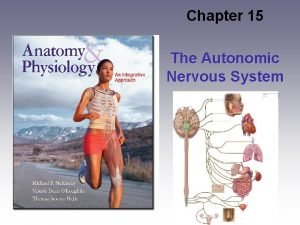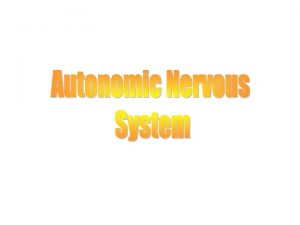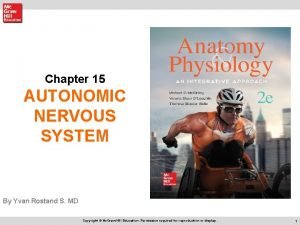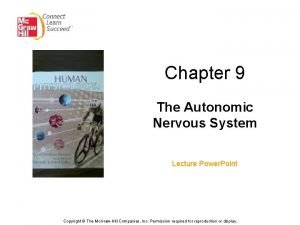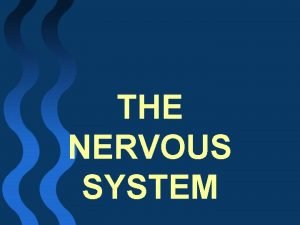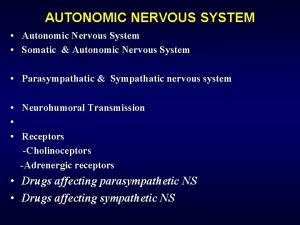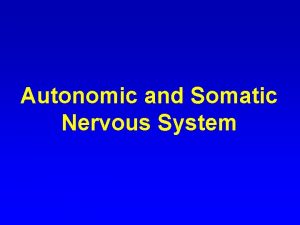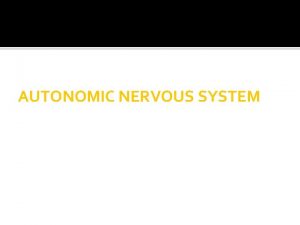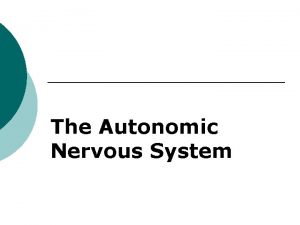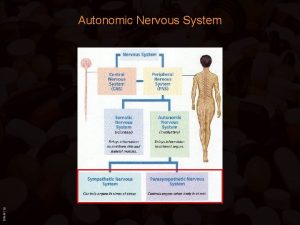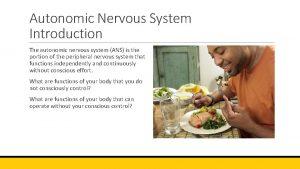Autonomic Nervous System Chapter 11 Comparison Somatic systems














- Slides: 14

Autonomic Nervous System Chapter 11

Comparison �Somatic systems- conscious awareness �Autonomic sensory - not consciously perceived ◦ Monitors internal conditions- blood gasses, viscera operation, etc �Autonomic motor- cardiac muscle, smooth muscle & glands ◦ Often adjustment of internal controls in relation to whole body needs

Motor pathways �Somatic motor neurons go directly from spinal cord to skeletal muscle �Autonomic motor systems includes two motor neurons: �Preganglionic neuron from CNS to autonomic neuron from cell body in ganglion to effector

Divisions � Sympathetic division � Parasympathetic division � both divisions often innervate the same effector � They have opposite effects � E. g. sympathetic stimulates heart rate and parasympathetic slows it

Figure 11. 1 a

Figure 11. 1 b

Sympathetic division � Thoracolumbar division- ◦ outflow from thoracic & lumbar segments of spinal cord � Preganglionic fibers – � From lateral horns via ventral roots � to sympathetic ganglia � synapse with postganglionic cells in ganglia

Preganglionic Routing

Parasympathetic Neurons

Neurotransmitters �Acetylcholine- ◦ ◦ All preganglionic fibers terminals parasympathetic postganglionic terminals A few postganglionic sympathetic terminals Short-lived effects �Norepinephrine- ◦ Most postganglioic sympathetic terminals ◦ Longer effects ◦ Amplified by adrenal release with epinephrine

ANS Activity � Balance between sympathetic & parasympathetic “tone” regulated through hypothalamus � Only sympathetic to: ◦ Sweat glands, arrrector pili muscles, kidneys, spleen, blood vessels & adrenal medulla

Sympathetic Effects � fight-or-flight activities Dilate pupils Increase HR, heart contraction & BP Dilate airways Constrict blood vessels to non essential organs: kidneys, GI tract ◦ Dilate vessels to muscles, cardiac muscle, liver & adipose ◦ Mobilize nutrients: glucose & fats ◦ ◦

Parasympathetic Effects �Rest-and–digest �SLUDD act ivies ◦ Salvation ◦ Lacrimation ◦ Urination ◦ Digestion ◦ Defecation ◦ Decrease- HR, airway diameter, pupil diameter

Wrap UP!! What have we learned? � Differentiation of the ANS vs the SNS � Divisions of the Parasympathetic vs Sympathetic systems � Nerve pathway for each system along with the associated neurotransmitters and effects. � This content fulfills some of the requirements for TCOs: ◦ 1, 6 and 7
 Autonomic nervous system pathway
Autonomic nervous system pathway Main division of nervous system
Main division of nervous system Somatic and autonomic nervous system
Somatic and autonomic nervous system Parasympathetic
Parasympathetic Autonomic nervous system consists of
Autonomic nervous system consists of Spinal cord dorsal and ventral roots
Spinal cord dorsal and ventral roots Autonomic nervous system
Autonomic nervous system The autonomic nervous system controls
The autonomic nervous system controls Adrenal gland sympathetic nervous system
Adrenal gland sympathetic nervous system Autonomic dysreflexia
Autonomic dysreflexia Pre ganglionic
Pre ganglionic Sns pg
Sns pg Somatic nervous system
Somatic nervous system Neurotransmitter of somatic nervous system
Neurotransmitter of somatic nervous system Visceral nervous system
Visceral nervous system






